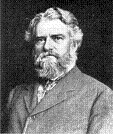

Simon Newcomb was born on 12 March 1835 in Nova Scotia, Canada, the son of a school master. As a child, he was tutored by his father, but left Canada for the United States, settling in Maryland in 1854. Newcomb studied at Harvard and later held positions at the American Nautical Office, Johns Hopkins University, and the Naval Observatory. He was editor of the American Journal of Mathematics from 1885 to 1900, and served as President of the American Mathematical Society from 1897 to 1898. Newcomb died on 11 July 1909 in Washington, DC.
Newcomb is mostly known for his work in astronomy, particularly the orbits of the planets and the moon. He also made contributions in calculus and analysis, in economics, and collaborated with Albert Michelson on the famous experiment to measure the speed of light. Newcomb wrote a number of popular textbooks in astronomy, and even a science fiction novel.
In probability, Newcomb is known for discovering the distribution that seems to govern the significant digits in real data sets. Newcomb evidently made this discovery by studying astronomical data and by noticing the varying degrees of wear in tables of logarithms. Newcomb's results were rediscovered and generalized by the engineer and physicist Frank Benford, and are now known as Benford's law in his honor.